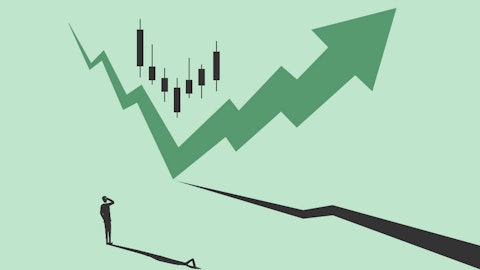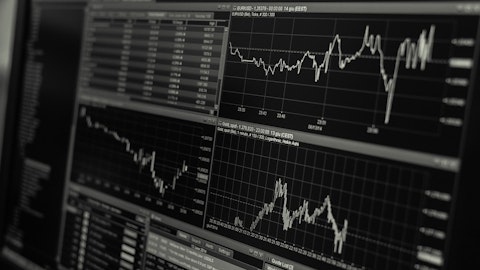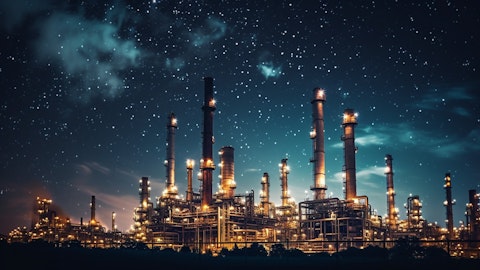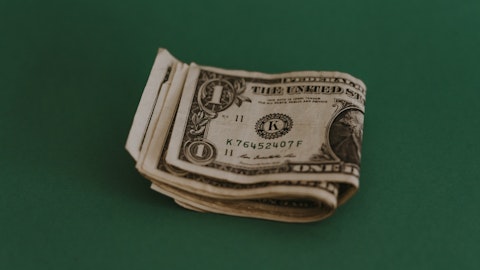Chevron Corporation (NYSE:CVX) Q4 2023 Earnings Call Transcript February 2, 2024
Chevron Corporation isn’t one of the 30 most popular stocks among hedge funds at the end of the third quarter (see the details here).
Operator: Good morning. My name is Katie, and I will be your conference facilitator today. Welcome to Chevron’s Fourth Quarter 2023 Earnings Conference Call. At this time, all participants are in a listen-only mode. After the speakers’ remarks, there will be a question-and-answer session and instructions will be given at that time. [Operator Instructions] As a reminder, this conference call is being recorded. I will now turn the conference call over to General Manager of Investor Relations of Chevron Corporation, Mr. Jake Spiering. Please go ahead.
Jake Spiering: Welcome to Chevron’s fourth quarter 2023 earnings conference call and webcast. I’m Jake Spiering, General Manager of Investor Relations. Our Chairman and CEO, Mike Wirth, and CFO, Pierre Breber, are on the call with me today. We will refer to the slides and prepared remarks that are available on Chevron’s website. Before we begin, please be reminded that this presentation contains estimates, projections and other forward-looking statements. Reconciliation of non-GAAP measures can be found in the appendix of this presentation. Please review the cautionary statement on Slide two. Now, I will turn it over to Mike.
Mike Wirth: Thanks, Jake, and thank you everyone for joining us today. Chevron delivered another year of solid results in 2023. During a time of geopolitical turmoil and economic uncertainty, our objective remained unchanged; safely deliver higher returns and lower carbon. Our clear and consistent approach resulted in an adjusted ROCE of 14% and enabled a record of $26 billion in cash return to shareholders, while growing production to accompany a record. We also successfully integrated PDC Energy and announced the Hess acquisition. We’re now focused on the FTC’s second request and expect to file the draft S4 later this quarter with closing anticipated around the middle of the year and we continue to take action in lowering the carbon intensity of our operations and growing lower carbon businesses, advancing foundational projects in both hydrogen and carbon capture.
Over the past five-year commodity cycle, with prices high, low and everywhere in between, Chevron led the peer group in what we believe are the most important measures that create value. We were the most capital efficient while managing unit costs well below inflation and many peers. Capital and cost discipline always matter in a commodity business. Combining this discipline with our focused portfolio of advantage assets, Chevron was able to lead the peer group in returning cash to shareholders. Our five-year dividend growth rate was greater than the S&P 500 and more than double our nearest peer. Surplus cash was returned to our shareholders in each of the past five years through share buybacks. Our track record has proven and we intend to continue growing value for our shareholders in any environment.
In the Permian, we delivered on our full-year production guidance. Instead, a quarterly record of 867,000 barrels of oil equivalent per day, while building our DUC inventory in the fourth quarter. Looking to the year ahead, our program is back-end loaded as we plan to continue to build our DUC inventory before adding an additional completion crew in the second half of the year. As a result, we expect production in the first half of the year to be down from the fourth quarter by about 2% to 4% before climbing toward a 2024 exit rate around 900,000 barrels per day. Chevron is a clear leader in Permian financial returns in the Permian with our unique royalty advantage and strong execution across a diverse portfolio. We have strong momentum and expect to achieve one million barrels of oil equivalent per day in 2025.
At TCO, we’re making progress towards the first phase of WPMP FGP start-up. The slide shows how the project fits within the overall field and facilities. The field, currently flowing at high pressure, continues to keep the existing plants full. In fact 2023 net production was the highest since 2020. We’ve completed a lot of project scope that is already operational. TCO is producing from the new wells. The upgraded and new utilities, gathering system, control center and power distribution system are all currently in operation. For WPMP, we’re focused on starting up major equipment – including gas turbine generators, pumps and compressors. We expect to hand over to operations the first pressure boost compressor in March for final dynamic commissioning.
Once we have PBF compression online, WPMP start-up is expected to begin in the second quarter when the first metering station is converted to low pressure, which will enable increased flow rates. Low pressure production streams going back to existing process units will be driven by the pressure boost compression. At the same time, production from metering stations not yet converted will continue to flow in the high-pressure system. We expect metering station conversions through the remainder of the year as additional pressure boost compressors start up, keeping the existing plants full around planned KTL and SGI turnarounds For FGP, we’re focused on starting up additional gas turbine generators and compressors along with multiple processing units.
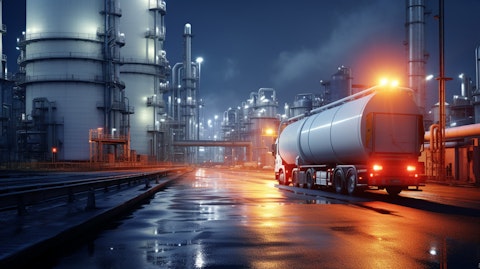
The sour gas injection facilities have already been handed over to operations for final commissioning. FGP start-up is expected in the first half of next year when incremental production enabled by field conversion to low pressure will be processed in the new 3GP facility. Since last quarter, two boilers came online and two gas turbine generators have delivered power. We’ve seen improvement in work scope delivery and have been working through additional discovery items. We’ll continue to update you on progress and remain focused on key milestones to deliver a safe and reliable start-up. With that, I’ll turn it over to Pierre to discuss the financials.
Pierre Breber: Thanks Mike. We reported fourth quarter earnings of $2.3 billion, or $1.22 per share. Adjusted earnings were $6.5 billion, or $3.45 per share. Included in the quarter were $3.7 billion in charges pre-announced in January. Foreign currency charges were almost $480 million. Our 2023 CapEx included $650 million of inorganic acquisitions and around $450 million invested in legacy PDC assets post-closing. Excluding these items, CapEx was about 5% above budget after three consecutive years below. Share repurchases matched the third quarter. Our balance sheet remains strong, ending the year with a net debt ratio comfortably in the single digits. Turning to the quarter, adjusted earnings were higher than last quarter by roughly $730 million.
Adjusted upstream earnings improved due to higher liftings, in line with record quarterly production, and favorable timing effects. Adjusted Downstream earnings decreased on lower refining margins, partially offset by a favorable swing in timing effects. All Other benefited from lower corporate taxes and employee costs. For the full year, adjusted earnings decreased nearly $12 billion compared to the prior year. Adjusted Upstream earnings decreased primarily due to lower prices. Adjusted Downstream earnings were lower largely due to declining refining margins. Other segment earnings improved on lower employee costs and higher interest income. Solid financial performance enabled Chevron to deliver, again, on all four of its financial priorities.
We announced an 8% increase in our dividend, reflecting our confidence in expected future free cash flow growth. We maintained capital discipline in both traditional and new energies. We reduced debt by over $4 billion, including all debt assumed in the PDC acquisition and we repurchased about 5% of our shares outstanding. Last year, we produced more oil and gas than any other year in the company’s history, including a record number of LNG cargoes out of Australia. We expect 2024 production to be higher again, by 4% to 7%. Our plans include production growth in the DJ Basin, with a full year of legacy PDC operations and continued organic growth in the Permian. Our guidance this year includes an estimated impact from asset sales as we further high-grade our portfolio.
Looking ahead, our first quarter downtime estimate includes around 20 thousand barrels of oil equivalent per day associated with January’s cold weather in North America. Earnings estimates from refinery turnarounds are mostly driven by Pascagoula. Share repurchases in the quarter will continue to be restricted under SEC regulations. Depending on commodity prices and margins, affiliate dividends are estimated around $4 billion, roughly flat with last year. We do not expect significant affiliate dividends in the first quarter. The difference between affiliate earnings and dividends is expected to decrease in the second half of the year after TCO’s start-up of WPMP. Our CapEx guidance range is unchanged from the December budget announcement.
In prior years, our CapEx rate in the first half of the year was about 20% lower than the second half. Our price sensitivities have increased at higher production levels. About 20% of the Brent sensitivity relates to oil-linked LNG sales and less than 10% relates to North America natural gas liquids. Back to you, Mike.
Mike Wirth: In closing, our priorities are clear: Safely execute with excellence, maintain capital and cost discipline; and return cash to shareholders. We’re excited about the pending Hess acquisition which will further strengthen Chevron. I also want to personally thank Pierre for his invaluable contributions over his 35-year career with the company. He’s been an exceptional strategic partner to me and an outstanding leader, helping guide Chevron to create significant value for shareholders. I wish him all the best in his retirement. I’ll now hand it off to Jake.
Jake Spiering: That concludes our prepared remarks. We are now ready to take your questions. We ask that you limit yourself to one question. We will do our best to get all your questions answered. Katie, please open the line.
See also 12 High Quality Headphones Under $100 and 15 Highest Quality Fast Food Burgers in the US.
Q&A Session
Follow Chevron Corp (NYSE:CVX)
Follow Chevron Corp (NYSE:CVX)
Operator: [Operator instructions] Our first question comes from Biraj Borkhataria with RBC.
Biraj Borkhataria: Hi, thanks for taking my question and firstly, Pierre, congrats on a great career and all the best for retirement and thanks for all the help over recent years. I feel compelled to ask you a question on buybacks because it’s your last time, but I’ll try and resist. So the question’s on the Permian. You had a very strong production number in Q4, quite an inflection from what we’ve seen in the last few quarters and I was interested in particular the comment on that volume growth alongside building the DUC inventory. So presumably the non-op side was a nice contribution in Q4. Could you just give some clarity on the bridge sort of 3Q to 4Q because the market has been concerned about you hitting the number of the lease for this year most recently. Thank you.
Pierre Breber: Sure. So, in the third quarter, non-op was a little light, but in the fourth quarter, it came back. It didn’t end the year. Non-op and royalty are right where we guided to from the beginning of the year. So, through a year, the quarterly ups and downs on some of these things, can create some questions, but it came in right as we guided to it in the mid-teens. The story on the fourth quarter was really strong execution. We had more POPs because we had faster drilling and faster cycle time on completions. We had a shorter cycle time from frack to POP. So all of those increased and as you noted, we did continue to build our DUC inventory because drilling performance was so strong. A couple other things, POPs in the fourth quarter were weighted towards New Mexico.
We had guided towards activity that would lead to more POPs in New Mexico in the second half of the year. Those wells are more productive than kind of on average than the rest of the portfolio. So that flows through. And then the final thing that I would point to is we had higher reliability. You’ll recall in the third quarter, we talked a little bit about some midstream constraints and other things that weren’t related to completions or POPs or anything else, but they were constraints on flow. We had fewer frack hits. We had fewer scheduled delays, weather downtime, and midstream issues in the quarter. So all of that contributed to the strong performance there in the fourth quarter and we ended the year right on our guidance.
Operator: We’ll go next to Neil Mehta with Goldman Sachs.
Neil Mehta: Yeah, thank you so much, Pierre. You’re going out in style, and thanks for all the great insights and wisdom over the years.
Pierre Breber: Thanks, Neil. My question’s on Slide six, the TCO update. It sounds like the schedule and the cost guidance that was provided in November is still on track, but for us non-engineers, maybe, Mike, you can kind of walk us through the schematic and help us understand what of these boxes are the critical path issues that we should be focused on.
Mike Wirth: Yeah. So, you’re right, Neil. The schedule and cost guidance is unchanged. I apologize for a more complex slide than we usually put out in front of you, but we want to be as transparent as we can and help people understand what’s going on there at the field. Last quarter, we talked about our action plan, and we’re seeing improved productivity. We’ve shifted scope amongst contractors. We’ve added more engineering support in the field and as we move through this, we’re encountering discovery work, as we expected. We found some around piping stress and alignment that we’re working on right now. The key thing to think about here is, first of all, there’s a lot of stuff that’s up and running. All the new wells are producing right now, all this infrastructure, in terms of utility and power distribution and control center, is up and running and as we — and so that’s keeping the plants full and we saw really strong performance last year.
I mentioned the strongest in four years and the fourth strongest in the history of the field. So, we’re seeing good deliverability out of the new wells, which is the key thing for production this year, is keeping those plants full while we begin to convert the field from pushing into a high-pressure plant to lower back pressure on the field, which improves deliverability from the wells and allows us to extend the life of the field and get up to a million barrels a day. So when we begin converting these metering stations and there are 21 of them, we will then take production from a metering station now that is producing under low pressure and we’ll boost that back up to get into the existing plant. As we get more and more of those converted, more of these pressure boost compressors online, we’ll get the whole field now producing against the lower back pressure, which gives us a lot of excess well capacity and it ensures that we are going to keep the plant full and as we then bring on the new process equipment, we start to route that low-pressure production into a plant that will run at lower pressure.
And so that’s really the kind of the high-level description of what we’re trying to convey there and we’ve got a legend that shows you certain things are going to begin start up in various quarters. For FGP, we’re focused on commissioning the major equipment there that will allow us to bring up the plant that will take us to a million barrels a day and we’re transferring learnings from compressors, pumps, and other things that we’re working on now, walking down all the critical substations and we’ll continue to provide updates on the key milestones here. We’re talking about a couple of gas turbine generators online. First quarter is the Inlet separator is ready for operation and we’ll commission that on sweet fluids as we prepare it for sour production and then, as I said, in the second quarter, we begin the PBF startup and metering station conversions.
So it’s all on track with our guidance and we will continue to provide you detail as we move forward each quarter on specific milestones and progress.
Operator: We’ll go next to Doug Leggate with Bank of America.
Doug Leggate: Thank you. Good morning, Pierre. I have to offer my congrats as well and with the quarter today, thanks for making us in the sales side look smart. It’s a nice way to go out. So best wishes in retirement.
Pierre Breber: Thank you, Doug.
Doug Leggate: My question, Mike, is I guess it’s got a part A and B, so apologies to Jake on that, but it’s kind of around disposals. Our understanding from the Hess side is that despite the fact that you haven’t filed the S4 yet, you haven’t got the FTC yet, and I realize those processes are ongoing, but the integration planning is still going ahead full steam and I’m just curious if you can offer any color on how that process has evolved as it relates specifically to portfolio high grading. The absence of Malaysia in your go-forward plan, for example, it seems to me the $15 billion number might have a lot of upside. So any color you can offer on that topic, please.
Mike Wirth: Yeah. Doug, it’s really premature for us to comment on that until the transaction closes. Hess has a pretty tight portfolio of assets that are performing well and we really need to close the deal, have access to all the data and re-optimize all of our views of portfolio investments and update our new plan and so I don’t want to speculate on any assets and look, we’ve got some of our own assets that we do have out in the public domain already. You may have seen reports on Kaybob Duvernay on Congo. So, there are some divestments that we have signalled out of the Chevron portfolio and I think as you see the divestments unfold over the next few years because we will have more assets in the portfolio that come from Legacy Chevron that is likely to be a greater contributor I would guess to the overall $10 billion to $15 billion number than things that come in through this transaction, but I can’t comment on Malaysia or any other particular asset until we get past the close.
